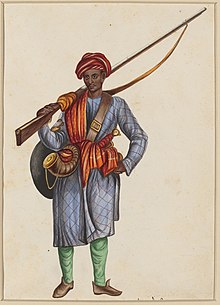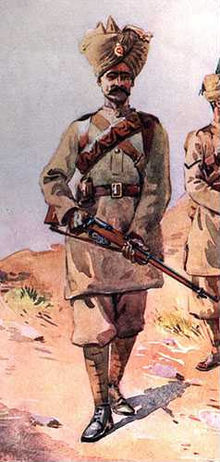Sepoy

A sepoy (/ˈsiːpɔɪ/) was formerly the designation given to an Indian soldier. In the modern Nepalese Army, Indian Army, Pakistan Army and Bangladesh Army it remains in use for the rank of private soldier.[1]
The East India Company recruited largely Indian troops, the lowest ranking being the sepoys, and trained them along European lines.[2]
The 19th century diplomat Sir Justin Sheil commented about the British East India Company copying the French Indian army in raising an army of Indians:
It is to the military genius of the French that we are indebted for the formation of the Indian army. Our warlike neighbours were the first to introduce into India the system of drilling native troops and converting them into a regularly disciplined force. Their example was copied by us, and the result is what we now behold. The French carried to Persia the same military and administrative faculties, and established the origin of the present Persian regular army, as it is styled. When Napoleon the Great resolved to take Iran under his auspices, he dispatched several officers of superior intelligence to that country with the mission of General Gardanne in 1808. Those gentlemen commenced their operations in the provinces of Azerbaijan and Kermanshah, and it is said with considerable success.
— Sir Justin Sheil (1803–1871).[3]
Etymology
The term "sepoy" is derived from the Persian word sepāhī (سپاهی) meaning "infantry soldier" in the Mughal Empire. In the Ottoman Empire the term Sipahi was used to refer to cavalry troopers.[4] In its most common application, sepoy was the term used in the British Indian Army, and earlier in that of the British East India Company, for an infantry private (a cavalry trooper was a sowar).
Historical usage
The term sepoy came into use in the forces of the British East India Company in the eighteenth century, where it was one of many, such as peons, gentoos, mestees and topasses used for various categories of native soldier. Initially it referred to Hindu or Muslim soldiers without regular uniform or discipline. It later generically referred to all native soldiers in the service of the European powers in India.[4] Close to ninety-six percent of the British East India Company's army of 300,000 men were native to India and these sepoys played a crucial role in securing the subcontinent for the company.[5]
Sepoys in the Mughal Empire


A Sipahi or a sepoy was an infantryman in both the Mughal Empire and the Kingdom of Mysore. The Mughal Emperor Aurangzeb (reigned 1658–1707) raised battalions of sepoys variously armed with matchlocks, rockets, and grenades. These troops were successfully employed in siege warfare, particularly during the Siege of Bidar, the Siege of Bijapur and the Siege of Golconda.
Sepoys in British service

Initially the British recruited sepoys from the local communities in the Madras and Bombay Presidencies, the emphasis being on recruits having adequate physique and being of sufficient caste. In the Bengal Army however, recruitment was only amongst high caste Brahmin and Rajput communities, mainly of the Uttar Pradesh and Bihar regions. Recruitment was undertaken locally by battalions or regiments often from the same community, village and even family. The commanding officer of a battalion became a form of substitute for the village chief or gaon bura. He was the mai-baap or the "father and mother" of the sepoys making up the paltan (from "platoon"). There were many family and community ties amongst the troops and numerous instances where family members enlisted in the same battalion or regiment. The izzat ("honour") of the unit was represented by the regimental colours; the new sepoy having to swear an oath in front of them on enlistment. These colours were stored in honour in the quarter guard and frequently paraded before the men. They formed a rallying point in battle. The oath of fealty by the sepoy was given to the East India Company and included a pledge of faithfulness to the salt that one has eaten.[4]
The salary of the sepoys employed by the East India Company, while not substantially greater than that paid by the rulers of Indian states, was usually paid regularly. Advances could be given and family allotments from pay due were permitted when the troops served abroad. There was a commisariat and regular rations were provided. Weapons, clothing and ammunition were provided centrally, in contrast to the soldiers of local kings whose pay was often in arrears. In addition local rulers usually expected their sepoys to arm themselves and to sustain themselves through plunder.[4]
This combination of factors led to the development of a sense of shared honour and ethos amongst the well drilled and disciplined Indian soldiery who formed the key to the success of European feats of arms in India and abroad.[4]
Following the Indian Rebellion of 1857 the surviving East India Company regiments were merged into a new Indian Army under the direct control of the British Crown. The designation of "sepoy" was retained for Indian soldiers below the rank of lance naik, except in cavalry where the equivalent ranks were sowar or "trooper".

Sepoys in French service
Following the formation of the French East India Company (Compagnie des Indes) in 1719, companies of Indian sepoys (cipayes) were raised to augment the French regulars and Swiss mercenary troops available. By 1720 the sepoys in French service numbered about 10,000.[6] Although much reduced in numbers after their decisive defeat in India at the Battle of Wandewash in 1760, France continued to maintain a Military Corps of Indian Sepoys (corps militaire des cipayes de l'Inde) in Pondicherry until it was disbanded and replaced by a locally recruited gendarmerie in 1898.[7]
Sepoys in Portuguese service
Sepoys were also recruited in Portuguese India. The term "cipaio" (sepoy) was also applied by the Portuguese to African soldiers in Angola, Mozambique and Portuguese Guinea, plus African rural police officers. Cipaios from Angola provided part of the garrison of Goa during the final years of Portuguese rule of that Indian territory.
Other usages
The same Persian word reached English via another route in the form of spahi. Zipaio, the Basque version of the word, is used by leftist Basque nationalists as an insult for members of the Basque Police,[8] implying that they are not a national police but servants of a foreign occupier.
In Hispanic American countries, especially in Argentina, the word cipayo has historically been used as a pejorative colloquial expression referring to individuals considered as serving foreign interests, especially those of the United States or Britain.[9]
See also
- Indian Rebellion of 1857 (termed by some The Sepoy Mutiny)
- Sowar, meaning "the one who rides" in Persian, was originally a rank during the Mughal, Maratha period.
- Jawan, the word used today to describe a soldier of the armies of India and Pakistan.
References
- ^ John Keegan, pages 312 and 545 "Armies of the World, ISBN 0-333-17236-1
- ^ Gerald Bryant (1978). "Officers of the East India Company's army in the days of Clive and Hastings". The Journal of Imperial and Commonwealth History. 6 (3): 203–27. doi:10.1080/03086537808582508.
- ^ Glimpses of Life and Manners in Persia by Lady Mary Leonora Woulfe Sheil, with additional notes by Sir Justin Sheil [1]
- ^ a b c d e Mason, Philip (1974). A Matter of Honour. London: Holt, Rhinehart & Winston. ISBN 0-03-012911-7.
- ^ "India's Sepoy Mutiny". Fsmitha.com. Retrieved 1 August 2012.
- ^ Rene Chartrand, Louis XV's Army - Colonial and Naval Troops, ISBN 1-85532-709-0
- ^ pages 50-51, Les Troupes de Marine 1622-1984, ISBN 2-7025-0142-7
- ^ La AN condena a dos años de cárcel al autor de los destrozos en el "bosque de Oma", Deia, 12 January 2005. Quoting a sentence from the Audiencia Nacional: «siendo público y notorio que el término "zipaio" es el que se da a los miembros de la Policía» vasca.
- ^ Qué significan cipayo, gorila fondos bruite y otras palabras que todos repiten y pocos conocen. Apertura.com
